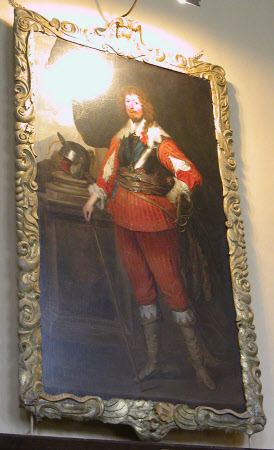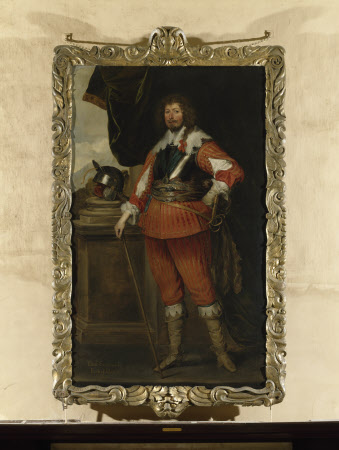Sir Edward Sackville, 4th Earl of Dorset (c.1590 – 1652)
after Sir Anthony Van Dyck (Antwerp 1599 - London 1641)
Category
Art / Oil paintings
Date
circa 1628 - 1649
Materials
Oil on canvas
Measurements
2178 x 1346 mm (85 3/4 x 53 in)
Place of origin
England
Order this imageCollection
Knole, Kent
NT 129730
Caption
Edward Sackville succeeded his brother, a notorious spendthrift who had impoverished the estate, in 1624. Edward held a number of Royal appointments, including Chamberlain to Queen Henrietta Maria, a station to which the key hanging from his waistband in this portrait presumably alludes. The key attached to the frame is said to be his key of office as Lord Chamberlain to Charles I, a position he held from 1644-1646. The painting was widely admired in the eighteenth century and thought to be by Van Dyck until the 1960s, when it was identified as studio work. Several related versions are known, including a miniature by John Hoskins (1585-1665) in the Victoria and Albert Museum.
Summary
Oil painting on canvas, Sir Edward Sackville, 4th Earl of Dorset (c.1590 – 1652), after Sir Anthony Van Dyck (Antwerp 1599 - London 1641), circa 1644/46. Inscribed on the front, bottom left: Edwd: Sackvill/Earle of Dorset/&c. A full-length portrait, turned slightly to the left, gazing at the spectator, standing, his left hand on his hip, his right hand on a stick, his helmet on a pedestal, left; he wears scarlet and gold embroidered jerkin and breeches with slashed sleeves, breastplate and sword, ribbon and garter medal; from the sash encircling his waist hangs his key of office, presumably as Chamberlain to Queen Henrietta Maria, to which he had been appointed in 1628. Neither Van Dyck nor his studio were still in existence by the time that Lord Dorset was appointed Lord Chamberlain of the Household of Charles I in 1644-46. The key attached to the actual frame on the bottom left corner is his key of office as Lord Chamberlain. Described by Clarendon as: "beautiful, graceful, and vigorous; his wit pleasant, sparkling, and sublime", Edward Sackville succeeded his brother, a notorious spendthrift who had impoverished the estate, in 1624. He had apparently sown his own wild oats as the keeper of Venetia Stanley, before her marriage in 1625 to Sir Kenelm Digby, who was his friend before and after his marriage, however, and wrote of him in his Memoirs, under the name of 'Mardontius'. It may have been because of a previous amorous entanglement that he fought the notorious duel near Bergen-op-Zoom in 1613, in which he killed his opponent, Edward Bruce, 2nd Lord Kinloss. He was a firm but moderate Royalist, whose appointments included: Ambassador to Louis XIII, 1621; High Steward of Yarmouth, 1629-52; Commissioner for planting Virginia, 1631 and 1634; Lord Privy Seal and President of the Council, 1644. He was K.B. in 1616, and K.G. in 1625; Chamberlain to Henrietta Maria in 1628, and Lord Chamberlain to the Household in 1644-46. He married Mary, daughter of Sir George Curzon, in or before 1612; she became governess to the royal children in 1630, until her death in 1645. They had a daughter, Mary, who died young in 1632, and two sons: Richard, who succeeded as 5th Earl (1622 - 77); and Edward, who was wounded at the Battle of Newbury (1643), and was subsequently taken prisoner and murdered in cold blood by Parliamentary troops at Chawley, Oxon. in 1646, shortly after his marriage to Bridget, Baroness Norreys. After being a signatory to the Capitulation of Oxford in June 1646, Dorset took no further part in public affairs; following the King's execution in January 1649, he is said never to have left his house in Salisbury Court, Fleet Street, until his death. James Howell wrote an elegy for him, entitled Ah-Ha, Tumulus Thalamus (1653).
Provenance
NOT in 1706 inventory: ?original, having escaped to Clarendon coll (?), still not replaced, yet:] 1728: recorded as an original Van Dyck by Vertue, and again in 1731 ('bon') and in 1737, when he drew it (for the engraving used four years later in Birch's Heads); 1799 inventory: 'Edward Earl of Dorset 4 Vandyck', in the Ball Room; on loan from the Trustees of the Sackville Estate
Credit line
Knole, The Sackville Collection (National Trust)
Makers and roles
after Sir Anthony Van Dyck (Antwerp 1599 - London 1641), publisher
References
Vertue 1730/50 in George Vertue, ‘Notebooks’, I-VIII, Walpole Society, VI Vol.XXIX (1949), p.72, Vertue, II, p.50 [1728]; IV, pp. 18 [1731], 123 [1737] Smith 1829-42 John Smith, A Catalogue Raisonné of the Works of the Most Eminent Dutch, Flemish, and French Painters, 8 vols and supplement, London, 1829-42, 1831, III, No. 379 Cust 1900: L. Cust. Anthony van Dyck, 1900, pp. 125, 274, No. 77 Schaeffer, 1909: E.Schaeffer, Van Dyck (Klassiker der Kunst) 1909 , No. 403 Millar 1961 Oliver Millar, 'Painting and the Age of Charles II', Connoisseur, January 1961, p.3 Larsen, 1980: Eric Larsen, L’opera completa di Van Dyck, Classici dell’Arte, 2 vols, Milan, 1980, No. 770:

